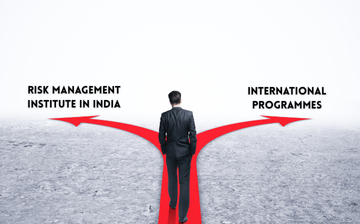
Risk Management Institute in India vs. International Programs
Risk Management Institute in India vs. International Programs: Which Is Better?
The modern business environment is highly complex and often volatile. Risk management is no longer just a strategic requirement—it has become a necessity. The demand for trained professionals in this field is growing rapidly as institutions and companies across the world face challenges ranging from economic downturns to cybersecurity threats.
This demand is being addressed by a wide range of institutes, both in India and abroad. For aspiring professionals, the key question is whether to pursue a course with a risk management institute in India or to enroll in an international program.
This article examines the merits and challenges of both, helping students and professionals make informed decisions based on career goals, budget, and learning preferences.
Understanding Risk Management Education
Risk management as a profession involves identifying, assessing, and managing risks across financial, operational, strategic, and technological domains. Courses today include advanced diplomas, postgraduate programs, and global certifications in areas like enterprise risk management, financial risk, and operational risk.
Both Indian and international institutes have adapted to these evolving requirements, aligning their curricula with global standards. However, differences remain in terms of accessibility, affordability, exposure, and recognition.
Indian Institute of Risk Management: Strengths and Challenges
Strengths:
- Affordability and Accessibility
Indian institutes generally offer cost-effective programs compared to foreign universities. Flexible fee structures, scholarships, and part-time learning options make it easier for working professionals to upskill without leaving their jobs. - Localized Curriculum
Programs are designed with a focus on India’s regulatory frameworks, economic systems, and market-specific risks. This is especially useful for professionals aiming to work in domestic sectors such as banking, insurance, and consulting. - Industry Collaboration
Leading institutes like the Global Risk Management Institute (GRMI), IIMs, and NIBM actively collaborate with banks, fintech companies, and consulting firms. This ensures practical exposure through case studies, projects, and placement opportunities. - Short-Term Programs
Many Indian institutes offer postgraduate diplomas or certifications that can be completed in 6–12 months, allowing quicker entry into the job market.
Challenges:
- Limited International Recognition
Despite delivering quality education, Indian qualifications often lack global visibility. This may affect career prospects for professionals seeking opportunities abroad. - Varied Quality Standards
Not all institutes maintain the same level of academic rigor or industry alignment. Students must carefully research program credibility before enrolling.
International Risk Management Programs: Strengths
- Global Recognition
International qualifications often carry worldwide acceptance, making them valuable for professionals who aspire to work across regions or with multinational firms. - Comprehensive Curriculum
Many global programs cover a wide spectrum of risks, including climate-related, geopolitical, and cross-border regulatory issues, offering a broader outlook than country-specific courses. - Advanced Infrastructure and Faculty
Universities abroad typically offer state-of-the-art facilities, strong research opportunities, and faculty with global expertise. - Networking Opportunities
Exposure to international peers, diverse industries, and cross-cultural environments helps students build a global professional network.
A Balanced Approach – Hybrid Learning
Given the pros and cons of both paths, many students adopt a hybrid strategy. They start with a strong foundation at a reputed Indian institute and later complement it with an internationally recognized qualification.
Some Indian institutes also collaborate with global universities to offer joint certifications, dual diplomas, or exchange opportunities. This model combines affordability with international exposure, helping students maximize their return on investment.
How GRMI Bridges the Gap
Among India’s leading institutions, the Global Risk Management Institute (GRMI) has emerged as a strong player in bridging the gap between local and global standards.
GRMI offers a Postgraduate Diploma in Risk Management (PGDRM) designed by industry veterans and global practitioners. The curriculum covers financial, operational, strategic, and cybersecurity risks, ensuring students gain well-rounded expertise.
What sets GRMI apart is its ability to blend global best practices with localized insights tailored to Indian and Asian markets. The institute also emphasizes practical exposure through live projects, internships, and industry collaborations.
With strong corporate partnerships, GRMI ensures that students are job-ready not only for the Indian market but also for roles with global relevance. The program also prepares graduates to pursue international certifications if they wish, strengthening their career mobility.
Conclusion
The choice between Indian and international risk management programs depends less on which is “better” and more on which is better for you.
- If you want affordability, localized industry relevance, and quicker pathways to employment, Indian institutes like GRMI provide excellent options.
- If your goal is international mobility and exposure to global markets, international programs may be more suitable.
- For many, a hybrid approach—starting with a strong domestic program and later adding an international credential—delivers the best of both worlds.
Risk management is one of the fastest-growing professions, and the right educational path can shape a successful and globally relevant career.
You may also like

Career in Cybersecurity Without Coding: Is It Possible?

Common Myths About Post Graduate Degree Programs


